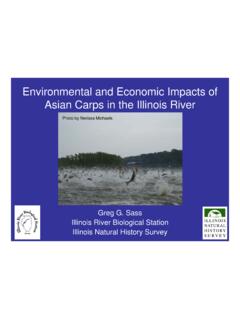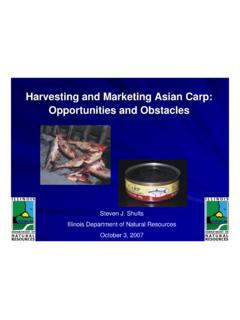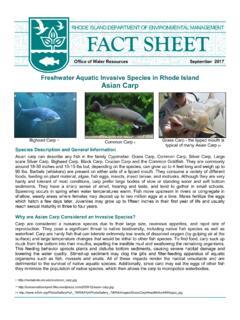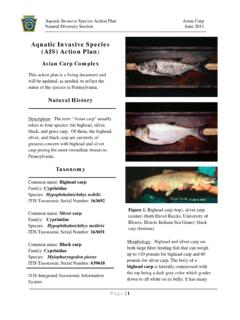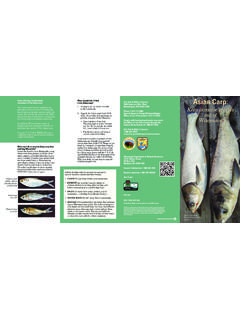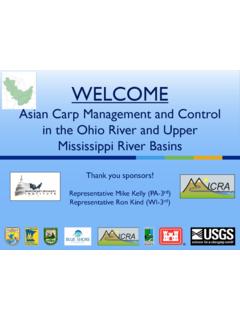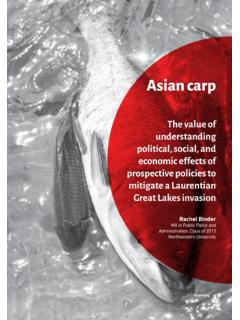Transcription of U.S. ARMY CORPS OF ENGINEERS Building Strong®
1 Pheromones ARMY CORPS OF ENGINEERS Building Strong ARMY CORPS OF ENGINEERS APRIL 2012 Robin Calfee, a biologist with USGS, sets up an experiment to determine what scents attract asian carp. Such knowledge may be useful in population control efforts. ANS Control: Repellant and Attractant Pheromones Targeted Species: Pheromones are a potential control method for fish. Specific ANS of Concern CAWS1 that are being studied include bighead carp (H. nobilis), black carp (Mylopharyngodon piceus),silver carp (Hypophthalmichthys molitrix) and sea lamprey (Petromyzon marinus). Selectivity: Pheromones are designed to control or manage some species of fish, however, the effects on other organisms are not known.
2 Developer/Manufacturer/Researcher: The main researchers of this technology include: the Geological Survey [(USGS (Ed Little, Robin Calfee, and Holly Puglis)]; Columbia Environmental Research Center, Columbia, MO; Peter Sorensen, University of Minnesota, Minneapolis, MN; and Dean Gilligan, Industry & Investment NSW, Invasive Animals Cooperative Research Centre, Hillston, New South Wales, Australia. Brief Description: Pheromones are secreted or excreted chemical factors that trigger a social response in members of the same species. They can be either an attractant or repellant. Three categories of pheromones can be discerned based on their function: anti-predator cues, social cues, and reproductive cues.)
3 Each of these categories comprises pheromones that can induce primer effects (developmental and/or endocrinological changes) and/or releaser effects (strong behavioral changes). Anti-predator pheromones are volatile substances released by some species when attacked that can trigger either fight or flight with surrounding fish of the same species. When studied, asian carp tend to distance themselves from the area where the alarm chemical was released. Numerous studies show that fish exhibit evasive (alarm or fright reactions) responses to the odor of damaged conspecifics (same species), or predators that have eaten conspecifics. In many fishes, including goldfish and common carp, conspecific odor promotes aggregation and shoaling.
4 This response is apparently not based on immediate familial relationship, although this aspect has largely been ignored. Both bile acids and L-amino acids have been implicated in species-recognition, but little research has been directed to this question (Sorensen & Stacey 2004). Pheromones are collected by filtering fish holding water or through tissue extraction. Some pheromones can be synthetically manufactured. 1 For a complete list of the 39 specific ANS of Concern CAWS, please see Table 1 of the main report. Source: Columbia Daily Tribune (Columbia, MO) Pheromones | 2 of 3 ARMY CORPS OF ENGINEERS APRIL 2012 Numerous species of fish, including cyprinids such as bighead and silver carp, have an alarm pheromone that is produced by cells in the outermost epidermal layer of fish skin (Pfeiffer 1977).
5 The substance is released into the water upon damage to the layer of skin overlying the scales as would occur during attack by a predator. This substance, initially described 60 years ago, induces a fright reaction in conspecifics which may include freezing, heightened swimming, or rapid escape from the area. Some other species will also avoid areas where the alarm substance is present. In minnows, the alarm substance persists for hours in water, is not affected by freezing, and apparently is unaffected by digestion after a predator consumes fish containing the substance. In such cases, the alarm substances scent the predator and its feces (Little et al.)
6 2011). The USGS is conducting field studies on asian carp (bighead and silver) to evaluate the effectiveness of hormonally-induced sex pheromone production in caged female carp, as an attractant to aid in the capture of wild carp. Initial findings indicate high sensitivity of the carp s sense of smell to sex hormone metabolites associated with sex pheromones; these metabolites result from chemical processes in the fish s body. A feeding stimulus was also developed, which was attractive to the asian carp during field testing. Attractant pheromones may be used in practice to draw asian carp into an area where other Controls could be applied. Prior Applications: Pheromone deterrents are still in the research phase for a variety of species.
7 This Control has been tested in a variety of fish, including: goldfish (Saglio & Le Martret 1982; Saglio & Blanc 1983); common carp (Industry and Investment NSW 2010); salmon (Moore & Waring 1996); eels (Sorensen 1986); sea lamprey (Sorensen et al. 2003) ; and asian carp (Little et al. 2011). General Effectiveness: In the past, chemical control measures have been applied to control invasive organisms, such as the lamprey in the Great Lakes. Pheromones appeal to the Great Lakes sea lamprey program because they may enhance the existing control strategies (Li et al. 2003). Sorensen et al. (2003) demonstrated that the migratory pheromone plays a key role in determining adult lamprey distribution.
8 Operating Constraints: If pheromones are classified as pesticides by regulatory agencies, a National Pollutant Discharge Elimination System permits would be required for application. The effects of pheromones are temporary and diminish as the target organism acclimates to constant application. Effectiveness of this Control may prove to be short-term. Cost Considerations: Implementation: Implementation costs would include developing and manufacturing the pheromone, developing a plan for their use, and construction of any feature required for delivery and application. Planning and design activities in this phase may include research and development of this Control, modeling, site selection, site-specific regulatory approval, plans and specifications, and real estate acquisition.
9 Design will also include analysis of this Control s impact to existing waterway uses including, but not limited to, flood risk management, natural resources, navigation, recreation, water users and dischargers, and required mitigation measures. Pheromones | 3 of 3 ARMY CORPS OF ENGINEERS APRIL 2012 Operations and Maintenance: Operations and maintenance costs would include continuous application of pheromones and an effectiveness monitoring program. Mitigation: Design and cost for mitigation measures required to address impacts as a result of implementation of this Control cannot be determined at this time. Mitigation factors will be based on site-specific and project-specific requirements that will be addressed in subsequent, more detailed, evaluations.
10 Citations: Industry and Investment NSW. 2010. Female carp lure males to trap. Science Alert, Australia and New Zealand. Accessed June 8, 2011. Li, W., Siefkes, Scott & J. Teeter. 2003. Sex pheromone communication in the sea lamprey: implications for integrated management. Journal of Great Lakes Research, vol. 29 (Supplement 1), pp. 85-94 Little, , Calfee, Fabacher, & L. Sanders. 2011. Fright reaction and avoidance induced by exposure to conspecific skin extracts in invasive bighead and silver carps . American Fisheries Society Symposium, vol. 74, pp. 215-225 Moore, A. & Waring. 1996. Electrophysiological and endocrinological evidence that F-series prostaglandins function as priming pheromones in mature male Atlantic salmon (Salmo salar) parr.
